If you’re wondering if you need crawl space wall insulation and encapsulation, this is the article for you. Some homeowners believe once they insulate their crawl space, they solve all their problems. Others believe the only step needed to protect their crawl space is encapsulation. Once you’re finished with this article, you’ll understand why you need both.
What Is Crawl Space Wall Insulation?
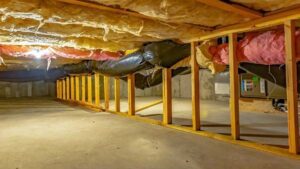 Crawl space wall insulation is when you apply fiberglass batts, foam boards, or spray foam to the concrete walls in the space below your home. Insulation can help prevent warm or cold air from entering your crawl space, reducing the chance of mold growth, wood rot, and pest problems.
Crawl space wall insulation is when you apply fiberglass batts, foam boards, or spray foam to the concrete walls in the space below your home. Insulation can help prevent warm or cold air from entering your crawl space, reducing the chance of mold growth, wood rot, and pest problems. Which Insulation Should You Choose?
As mentioned above, there are three main types of insulation: fiberglass batts, foam boards, and spray foam. Experts will usually choose spray foam as their method of choice.
Here are some benefits of spray foam.
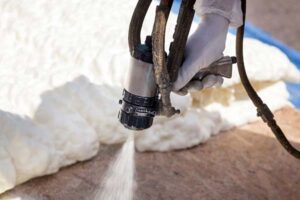
It’s safe for the environment.
It’s Class One Fire Rated (slows down the rate at which it will spread flames, saving your home from burning fast during a fire).
It does not retain water, unlike other insulation types that can absorb moisture.
It creates a stronger air seal than other insulation.
Pest won’t eat spray foam, making it harder for animals and insects to live in your crawl space.
Note: There are two types of spray foam insulation: open-cell and closed-cell. Open-cell spray foam is not completely waterproof and will allow moisture to pass through. Closed-cell spray foam is completely moisture-resistant.
This is where encapsulation comes in. Because closed-cell spray foam is already moisture-resistant and creates an airtight seal, you do not need to encapsulate your crawl space if you use this insulation. If you choose open-cell spray foam, you will need to encapsulate your crawl space in order to seal off air and moisture completely.
What Is Crawl Space Encapsulation?
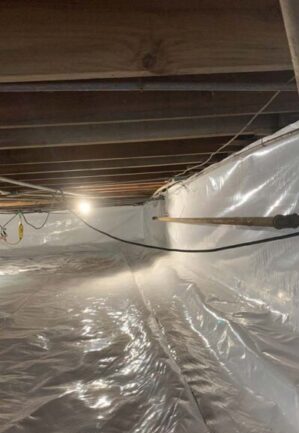
Crawl space encapsulation is when foundation waterproofing experts line the floors and walls of the space below your home with a vapor barrier. This thin polyethylene (widely used plastic) sheet is around 10 to 20 millimeters thick. Vapor barriers are impermeable, meaning they don’t allow water to pass through, and antimicrobial, meaning they help prevent mold growth.
Note: Mold can grow underneath or behind vapor barriers if organic matter is present. That’s why professionals always clean and clear the area, so there is nothing for mold to grow on.
When water passes through your crawl space concrete walls, the vapor barrier will catch it before it diffuses into the air. Once the moisture hits the sheeting, it drips down between the barrier and concrete until it reaches a drain tile system at the bottom. From here, the water is channeled through a perforated pipe until it’s ejected away from your home using a sump pump and discharge lines.
When Do You Need Both?
If you choose to insulate your crawl space with anything except closed-cell spray foam, you will need insulation and encapsulation. Insulation will prevent air from entering or escaping your basement, but it won’t stop moisture diffusion. If you have issues with moisture and standing water, you need encapsulation. If you have issues with cold floors and frozen pipes, you need insulation. If your crawl space suffers from all these problems, which are all closely associated, you need both.
Insulation should be applied after you encapsulate your crawl space. If you line your crawl space with a vapor barrier after you insulate the walls, moisture and air will become trapped in between. If you want to finish your crawl space and turn it into a storage area, a vapor barrier will prevent your drywall from water damage or mold.
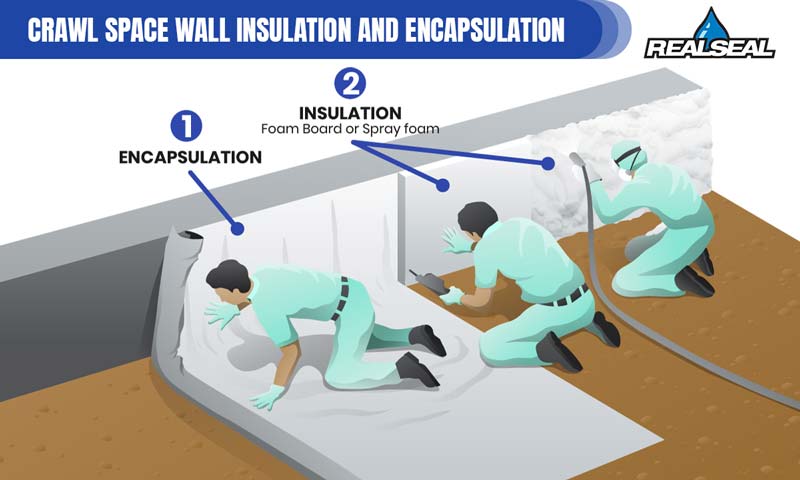
Who Do You Call?
If your crawl space is wet, cold, humid, or experiencing rapid influxes in temperature, call The Real Seal. We don’t provide insulation, but we’ll get you on the right path with encapsulation. Before you insulate, encapsulate. Our foundation waterproofing experts will inspect your crawl space and determine why moisture is building up underneath your home. Whether it’s a leaking crack, rising groundwater, or improperly sealed previous encapsulation, we’ll fix it. If we discover that your crawl space also needs structural repairs, we can help with that too. Call The Real Seal today for your free inspection and quote.
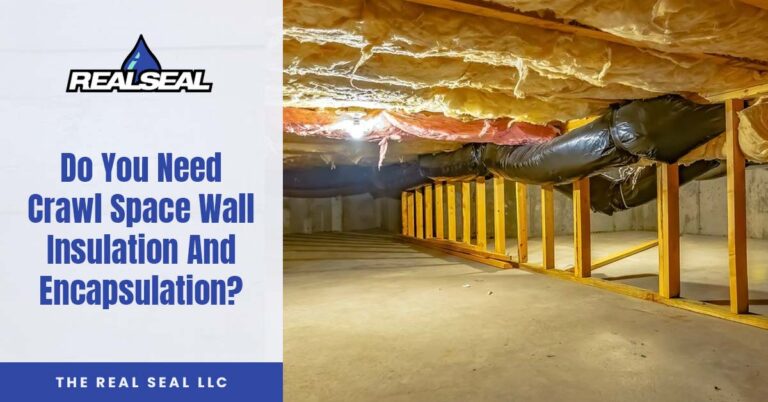
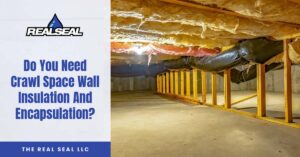





2 Responses
I’m having my crawl space encapsulated and they are removing the insulation. There is about 18-24 inches of Crawlspace and the price does not include replacing the insulation.. Do I need to replace it and how long after do I wait
Hi Joe,
If you want warmer floors, it is a good idea to add insulation to the crawl space. You should be able to add it immediately after they do their work.